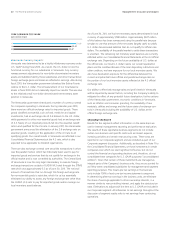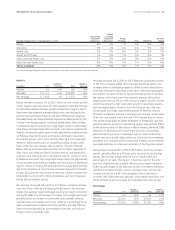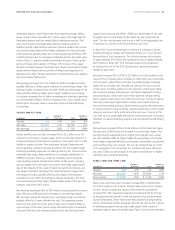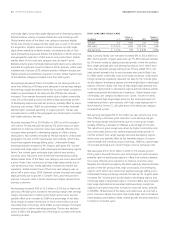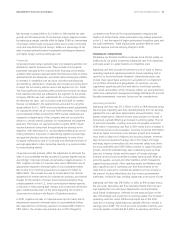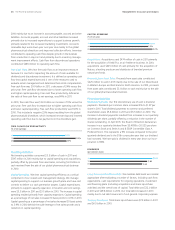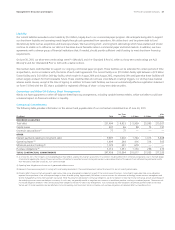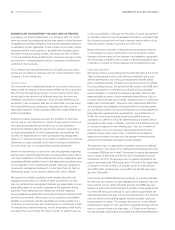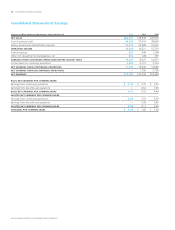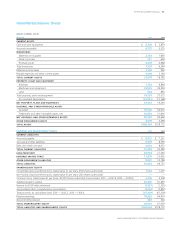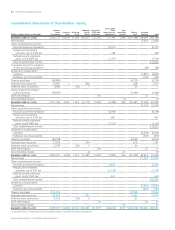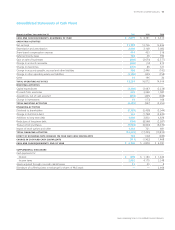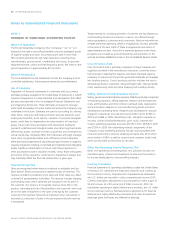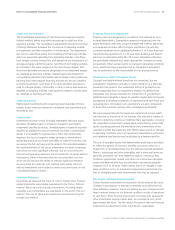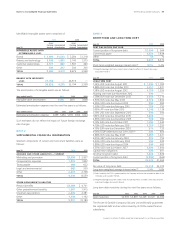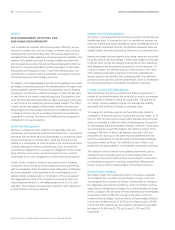Proctor and Gamble 2011 Annual Report Download - page 52
Download and view the complete annual report
Please find page 52 of the 2011 Proctor and Gamble annual report below. You can navigate through the pages in the report by either clicking on the pages listed below, or by using the keyword search tool below to find specific information within the annual report.50 The Procter & Gamble CompanyManagement’s Discussion and Analysis
with the organization change to the structure of the Beauty GBU.
These businesses represent some of our more discretionary consumer
spending categories. The Appliances business has goodwill of $.billion,
while the Salon Professional business has goodwill of $885million.
The estimated fair values of our Appliances and Salon Professional
businesses exceed their carrying values by approximately 10% and
30%, respectively. Because purchases in these categories are more
discretionary in nature, their operations and underlying fair values
were disproportionately impacted by the economic downturn that
began in fiscal2009, which led to a reduction in home and personal
grooming appliance purchases and in visits to hair salons. Our valua-
tion of the Appliances and Salon Professional businesses has them
returning to sales and earnings growth rates consistent with our
long-term business plans. Failure to achieve these business plans or a
further deterioration of the macroeconomic conditions could result
ina valuation that would trigger an impairment of the goodwill and
intangible assets of these businesses.
New Accounting Pronouncements
There were no new accounting pronouncements issued or effective
during the fiscal year which have had or are expected to have a
material impact on the Consolidated Financial Statements. For a
discussion of new accounting pronouncements, see Note 1to our
Consolidated Financial Statements.
OTHER INFORMATION
Hedging and Derivative Financial Instruments
As a multinational company with diverse product offerings, we are
exposed to market risks, such as changes in interest rates, currency
exchange rates and commodity prices. We evaluate exposures on a
centralized basis to take advantage of natural exposure correlation
and netting. Except within financing operations, we leverage the
Company’s broadly diversified portfolio of exposures as a natural hedge
and prioritize operational hedging activities over financial market
instruments. To the extent we choose to further manage volatility
associated with the net exposures, we enter into various financial
transactions which we account for using the applicable accounting
guidance for derivative instruments and hedging activities. These
financial transactions are governed by our policies covering acceptable
counterparty exposure, instrument types and other hedging practices.
Note 5to the Consolidated Financial Statements includes a detailed
discussion of our accounting policies for financial instruments.
Derivative positions can be monitored using techniques including
market valuation, sensitivity analysis and value-at-risk modeling. The
tests for interest rate, currency rate and commodity derivative positions
discussed below are based on the CorporateManager™value-at-risk
model using a one-year horizon and a 95% confidence level. The
model incorporates the impact of correlation (the degree to which
exposures move together over time) and diversification (from holding
multiple currency, commodity and interest rate instruments) and
assumes that financial returns are normally distributed. Estimates of
volatility and correlations of market factors are drawn from the
RiskMetrics™dataset as of June30,2011. In cases where data is
unavailable in RiskMetrics™, a reasonable proxy is included.
Our market risk exposures relative to interest rates, currency rates and
commodity prices, as discussed below, have not changed materially
versus the previous reporting period. In addition, we are not aware
of any facts or circumstances that would significantly impact such
exposures in the near term.
Interest Rate Exposure on Financial Instruments. Interest rate swaps
are used to hedge exposures to interest rate movement on underlying
debt obligations. Certain interest rate swaps denominated in foreign
currencies are designated to hedge exposures to currency exchange
rate movements on our investments in foreign operations. These
currency interest rate swaps are designated as hedges of the Company’s
foreign net investments.
Based on our overall interest rate exposure as of and during the year
ended June30,2011, including derivative and other instruments
sensitive to interest rates, we believe a near-term change in interest
rates, at a 95% confidence level based on historical interest rate
movements, would not materially affect our financial statements.
Currency Rate Exposure on Financial Instruments. Because we
manufacture and sell products and finance operations in a number
of countries throughout the world, we are exposed to the impact
on revenue and expenses of movements in currency exchange rates.
The primary purpose of our currency hedging activities is to manage
the volatility associated with short-term changes in exchange rates.
Corporate policy prescribes the range of allowable hedging activity. We
primarily use forward contracts with maturities of less than 18 months.
In addition, we enter into certain currency swaps with maturities of
up to five years to hedge our exposure to exchange rate movements
on intercompany financing transactions.
Based on our overall currency rate exposure as of and during the year
ended June30,2011, we believe, at a 95% confidence level based on
historical currency rate movements, the impact of a near-term change
in currency rates on derivative and other instruments would not
materially affect our financial statements.
Commodity Price Exposure on Financial Instruments. We use raw
materials that are subject to price volatility caused by weather, supply
conditions, political and economic variables and other unpredictable
factors. In addition to fixed price contracts, we may use futures,
options and swap contracts to manage the volatility related to the
above exposures.
Based on our overall commodity price exposure as of and during the
year ended June30,2011, we believe, at a 95% confidence level based
on historical commodity price movements, the impact of a near-term
change in commodity prices on derivative and other instruments would
not materially affect our financial statements.


